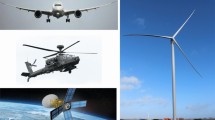Abstract
Methods that treat rigid/flexible multibody systems undergoing large motion as well as deformations are often accompanied with inefficiencies and instabilities in the numerical solution due to the large number of state variables, differences in the magnitudes of the rigid and flexible body coordinates, and the time dependencies of the mass and stiffness matrices. The kineto-static methodology of this paper treats a multibody mechanical system to consist of two collections of bulky (rigid) bodies and relatively flexible ones. A mixed boundary condition nonlinear finite element problem is then formulated at each time step whose known quantities are the displacements of the nodes at the boundary of rigid and flexible bodies and its unknowns are the deformed shape of the entire structure and the loads (forces and moments) at the boundary. Partitioning techniques are used to solve the systems of equations for the unknowns, and the numerical solution of the rigid multibody system governing equations of motion is carried out. The methodology is very much suitable in modelling and predicting the impact responses of multibody system since both nonlinear and large gross motion as well as deformations are encountered. Therefore, it has been adopted for the studies of the dynamic responses of ground vehicle or aircraft occupants in different crash scenarios. The kineto-static methodology is used to determine the large motion of the rigid segments of the occupant such as the limbs and the small deformations of the flexible bodies such as the spinal column. One of the most dangerous modes of injury is the amount of compressive load that the spine experiences. Based on the developed method, a mathematical model of the occupant with a nonlinear finite element model of the lumbar spine is developed for a Hybrid II (Part 572) anthropomorphic test dummy. The lumbar spine model is then incorporated into a gross motion occupant model. The analytical results are correlated with the experimental results from the impact sled test of the dummy/seat/restraint system. With this extended occupant model containing the lumbar spine, the gross motion of occupant segments, including displacements, velocities and accelerations as well as spinal axial loads, bending moments, shear forces, internal forces, nodal forces, and deformation time histories are evaluated. This detailed information helps in assessing the level of spinal injury, determining mechanisms of spinal injury, and designing better occupant safety devices.
Similar content being viewed by others
References
Kulief, J. A. and Shabana, A. A., ‘Impact responses of multibody systems with consistent and lumped masses’, Journal of Sound and Vibration 104(2), 1986, 187–207.
Bakr, E. M. and Shabana, A. A., ‘Geometrically nonlinear analysis of multibody systems’, Computers and Structures 23, 1986, 739–751.
Nagantham, G. and Soni, A. H., ‘Nonlinear modelling of kinematic and flexibility effects in manipulator design’, ASME Journal of Mechanisms, Transmissions and Automation in Design 110, 1988, 243–254.
Pereira, M. S. and Ambrosio, J. A. C., Computer-Aided Analysis of Rigid and Flexible Mechanical Systems, NATO/ASI Series, Series E: Applied Sciences, Vol. 268, Kluwer Academic Publishers, 1994.
Pereira, M. S. and Ambrosio, J. A. C., Computer-Aided Analysis of Rigid and Flexible Mechanical Systems-Volume II: Contributed Papers, Proceedings of the NATO/Advanced Science Institute, Troia, Portugal, June 1993.
Ambrosio, J. A. C., ‘Elasto-plastic large deformation of flexible multibody system in crash analysis’, PhD Dissertation, University of Arizona, 1991.
Bathe, K. J., Finite Element Procedures in Engineering Analysis, Prentice-Hall Inc., 1982.
Nikravesh, P. E., Computer-Aided Analysis of Mechanical Systems, Prentice-Hall Inc., 1988.
Laananen, D. H., Bolukbasi, A. O., and Coltman, J. W., ‘Computer simulation of an aircraft seat and occupant in a crash environment, Volume I—Technical report, TR-82401’, Simula Inc., Tempe, Arizona; DOT/FAA/CT-82/33-I, U.S. Department of Transportation, Federal Aviation Administration Technical Center, Atlantic City Airport, New Jersey, 1982.
Laananen, D. H., ‘Computer simulation of an aircraft seat and occupant(s) in a crash environment — Program SOM-LA/SOM-TA user manual’, DOT/FAA/CT-90/4, U.S. Department of Transportation, Federal Aviation Administration Technical Center, Atlantic City Airport, New Jersey, 1991.
Midoun, D. E., Abramoski, E., Rao, M. K., and Kalidindi, R., ‘Development of a finite element based model of the side impact dummy’, ASME Paper No. 930444.
Ma, D., ‘A multibody/finite element analysis approach for modeling of crash dynamic responses’, PhD Dissertation, Wichita State University, 1994.
‘Federal Aviation Regulations — Title 14 U.S. Code of Federal Regulations, Part 23, Amendment 23–29, Section 23.562’, Federal Register, August 15, 1988, effective in September 14, 1988.
Author information
Authors and Affiliations
Rights and permissions
About this article
Cite this article
Ma, D., Lankarani, H.M. A nonlinear finite-element approach for kineto-static analysis of multibody systems. Nonlinear Dyn 8, 237–250 (1995). https://doi.org/10.1007/BF00045776
Received:
Accepted:
Issue Date:
DOI: https://doi.org/10.1007/BF00045776



